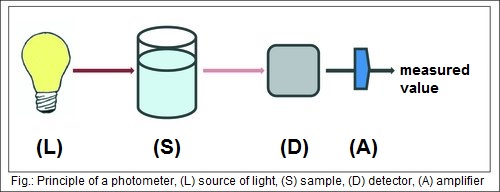Microplate Reader
A microplate reader makes it possible to analyse samples within single wells of a microtiter plate. Several signals (fluorescence, luminescence and changes in absorption) deriving from different marker molecules can be detected by microplate readers and provide information about the composition of the samples.
Microplate readers are used among others for the following applications:
- • Evaluation of ELISAs (ELISA reader)
- • Determination of protein and DNA concentrations
- • Measurement of enzyme activities
Microplate readers are based on the principle of a photometer. All instruments which are able to measure light intensity within liquids and gases are called photometers. For this it requires a source of light (s. Fig. L) which throws a beam of light through or rather on the sample (s. Fig. S) and a detector (s. Fig. D) which is able to measure the light intensity after passing the sample (absorption) or the light which is emitted by samples (fluorescence, luminescence). The detected signal is enhanced via an amplifier (s. Fig. A) and shown as measured value.

In this way, both, the emission of fluorescent and luminescent and the optical density of substances can be determined. A previously generated standard curve enables you to read off for example the concentration of antigens, proteins or DNA or the activity of enzymes with the help of the measured value. Different filters are available to vary the wavelength of the light for detection of diverse signals.
A microplate reader is a photometer with an automatic plate carrier. After completion of the experiment the microtiter plate is placed on a mobile plate carrier within the microplate reader for analysis. Via the plate carrier every single well automatically passes a source of light and a detector. This way the substances are measured. In the end you will get a value for every well.



